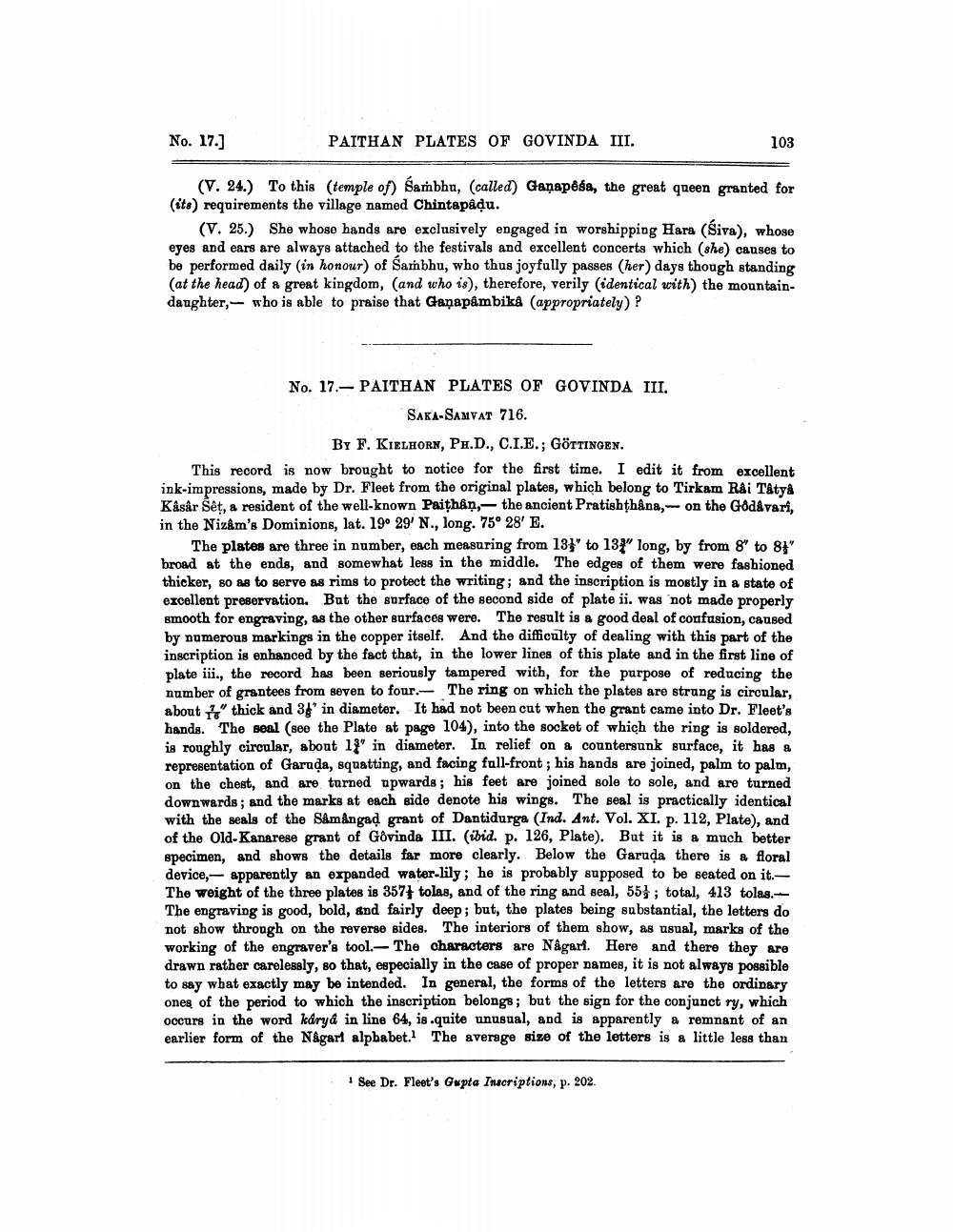________________
No. 17.]
PAITHAN PLATES OF GOVINDA III.
103
(V. 24.) To this temple of) Sambhu, (called) Ganapesa, the great queen granted for (its) requirements the village named Chintapadu.
(V. 25.) She whose hands are exclusively engaged in worshipping Hara (Śiva), whose eyes and ears are always attached to the festivals and excellent concerts which (she) causes to be performed daily (in honour) of Sambhu, who thus joyfully passes (her) days though standing (at the head) of a great kingdom, (and who is), therefore, verily (identical with the mountaindaughter, who is able to praise that Ganapambika (appropriately) ?
No. 17.- PAITHAN PLATES OF GOVINDA. III.
SAKA-SAMVAT 716.
By F. KIELHORN, PH.D., C.I.E.; GÖTTINGEN. This record is now brought to notice for the first time. I edit it from excellent ink-impressions, made by Dr. Fleet from the original plates, which belong to Tirkam Rai Tâtyå Käsår Set, a resident of the well-known Paithân,- the ancient Pratishthana, - on the Godåvari, in the Nizâm's Dominions, lat. 19° 29' N., long. 75° 28' E.
The plates are three in number, each measuring from 13}" to 134" long, by from 8' to 87' broad at the ends, and somewhat less in the middle. The edges of them were fashioned thicker, 80 as to serve as rims to protect the writing; and the inscription is mostly in a state of excellent preservation. But the surface of the second side of plate ii. was not made properly smooth for engraving, as the other surfaces were. The result is a good deal of confusion, caused by numerous markings in the copper itself. And the difficulty of dealing with this part of the inscription is enhanced by the fact that, in the lower lines of this plate and in the first line of plate iii., the record has been seriously tampered with, for the purpose of reducing the number of grantees from seven to four.- The ring on which the plates are strong is circular, about 1" thick and 3' in diameter. It had not been cut when the grant came into Dr. Fleet's hands. The seal (see the Plate at page 104), into the socket of which the ring is soldered, is roughly circular, about 13" in diameter. In relief on a countersunk surface, it has a representation of Garuda, squatting, and facing full-front; his hands are joined, palm to palm, on the chest, and are turned upwards; his feet are joined sole to sole, and are turned downwards; and the marks at each side denote his wings. The seal is practically identical with the seals of the Såmångad grant of Dantidurga (Ind. Ant. Vol. XI. p. 112, Plate), and of the Old-Kanarese grant of Govinda III. (ibid. p. 126, Plate). But it is a much better specimen, and shows the details far more clearly. Below the Garuda there is a floral device,- apparently an expanded water-lily; he is probably supposed to be seated on it.The weight of the three plates is 357 tolas, and of the ring and seal, 55}; total, 413 tolas. The engraving is good, bold, and fairly deep; but, the plates being substantial, the letters do not show through on the reverse sides. The interiors of them show, as usual, marks of the working of the engraver's tool. The characters are Någar. Here and there they are drawn rather carelessly, so that, especially in the case of proper Dames, it is not always possible to say what exactly may be intended. In general, the forms of the letters are the ordinary ones of the period to which the inscription belongs; but the sign for the conjunct ry, which occurs in the word karya in line 64, is.quite unusual, and is apparently a remnant of an earlier form of the Nagart alphabet. The average size of the letters is a little less than
See Dr. Fleet's Gupta Inscriptions, p. 202.




